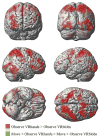A virtual reality-based system integrated with fmri to study neural mechanisms of action observation-execution: a proof of concept study
- PMID: 19531876
- PMCID: PMC5638304
- DOI: 10.3233/RNN-2009-0471
A virtual reality-based system integrated with fmri to study neural mechanisms of action observation-execution: a proof of concept study
Abstract
Purpose: Emerging evidence shows that interactive virtual environments (VEs) may be a promising tool for studying sensorimotor processes and for rehabilitation. However, the potential of VEs to recruit action observation-execution neural networks is largely unknown. For the first time, a functional MRI-compatible virtual reality system (VR) has been developed to provide a window into studying brain-behavior interactions. This system is capable of measuring the complex span of hand-finger movements and simultaneously streaming this kinematic data to control the motion of representations of human hands in virtual reality.
Methods: In a blocked fMRI design, thirteen healthy subjects observed, with the intent to imitate (OTI), finger sequences performed by the virtual hand avatar seen in 1st person perspective and animated by pre-recorded kinematic data. Following this, subjects imitated the observed sequence while viewing the virtual hand avatar animated by their own movement in real-time. These blocks were interleaved with rest periods during which subjects viewed static virtual hand avatars and control trials in which the avatars were replaced with moving non-anthropomorphic objects.
Results: We show three main findings. First, both observation with intent to imitate and imitation with real-time virtual avatar feedback, were associated with activation in a distributed frontoparietal network typically recruited for observation and execution of real-world actions. Second, we noted a time-variant increase in activation in the left insular cortex for observation with intent to imitate actions performed by the virtual avatar. Third, imitation with virtual avatar feedback (relative to the control condition) was associated with a localized recruitment of the angular gyrus, precuneus, and extrastriate body area, regions which are (along with insular cortex) associated with the sense of agency.
Conclusions: Our data suggest that the virtual hand avatars may have served as disembodied training tools in the observation condition and as embodied "extensions" of the subject's own body (pseudo-tools) in the imitation. These data advance our understanding of the brain-behavior interactions when performing actions in VE and have implications in the development of observation- and imitation-based VR rehabilitation paradigms.
Figures




References
-
- Fifth Dimension Technologies. 5DT Data Glove 16 MRI. from http://www.5dt.com.
-
- Adamovich S, Fluet G, Merians A, Mathai A, Qiu Q. Recovery of hand function in virtual reality: training hemi-paretic hand and arm together or separately. 28th EMBC Annual International Conference Engineering in Medicine and Biology Society; Vancouver, Canada. 2008. pp. 3475–3478. - PubMed
-
- Adamovich S, Merians A, Boian R, Tremaine M, Burdea G, Recce M, Poizner H. A virtual reality (VR)-based exercise system for hand rehabilitation post stroke. Presence. 2005;14:161–174. - PubMed
-
- Altschuler EL. Interaction of vision and movement via a mirror. Perception. 2005;34(9):1153–5. - PubMed
Publication types
MeSH terms
Substances
Grants and funding
LinkOut - more resources
Full Text Sources
Other Literature Sources

